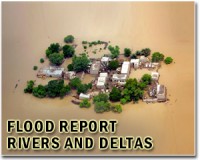| . |  |
. |
Paris (AFP) Feb 16, 2011 Global warming driven by human activity boosted the intensity of rain, snow and consequent flooding in the northern hemisphere over the last half of the 20th century, research released Wednesday has shown. Two studies, both published in Nature, are among the first to draw a straight line between climate change and its impact on potentially deadly and damaging extreme weather events. Australia, Sri Lanka, Brazil and Pakistan have all been recently ravaged by massive flooding, raising questions as to whether global warming was at least partly to blame. Computer models have long predicted that the observed rise in atmospheric greenhouse gases would magnify episodes of diluvian rainfall. But up to now, the link has been largely theoretical. "This paper provides the first specific evidence that this is indeed the case," said Francis Zwiers, a researcher at the University of Victoria in Canada and a co-author of one of the studies. "Humans influence the intensity of precipitation extremes," he told journalists in a telephone press conference. Data gathered between 1951 and 2000 from across Europe, Asia and North America showed that, on average, the most extreme 24-hour precipitation event in a given year -- whether rain, snow or sleet -- increased in intensity over the last 50 years of the 20th century. When this measurable spike was compared with changes simulated by climate models, the fingerprint of human influence on Earth's weather patterns was unmistakable, Zwiers said. "The observed change cannot be explained by natural, internal fluctuations of the climate system alone." The main driver was simply more water in the air. "In a warmer world the atmosphere has greater moisture-holding capacity," he explained. That doesn't necessarily mean that in a place where it doesn't rain very much precipitation will increase, he added. Indeed, some spots on Earth are likely to be drier. But it does mean that when a hurricane or snowstorm does occur, there is more water available. Why did it take so long for scientists to begin to make solid connections between global warming and extreme weather events? One reason is that only in recent decades has the accumulated influx of heat-trapping gases become more obvious. "We are finding it easier and easier to detect that signal in observations," Zwiers said. Progress has also been hampered by the lack of reliable, long-term data, and the sheer computer power needed to test ever-more complex computer models against reality. In the second study -- which sought to tease out the impact of global warming on England's wettest autumn on record, in 2000 -- scientists led by Myles Allen of the University of Oxford tapped into the power of Internet-based social networks to overcome this last constraint. The researchers compared two climate models, one based on detailed historical weather data and the other on a "parallel" autumn 2000 simulating conditions had no greenhouse gases been emitted in the 20th century. Global warming likely doubled the odds that such an event would occur, they found. "To really pin down the difference between these two worlds, we needed to repeat the simulation thousands of times," explained lead author Pardeep Pall, who initiated the project as a graduate student in 2003. "We asked members of the public across the world to run the simulations for us on their own personal computers using their idle time." Based on the results of the study, Britain national climate and weather office is developing tools to measure the human influence on future extreme weather events. "This kind of study is going to allow us to quantify how climate change is affecting people now so it ceases to be some hypothetical projection of the future," said Allen. The tool could also be useful in legitimating requests from developing countries seeking to tap into the hundreds of billions of dollars earmarked for climate adaptation, he said. Members of the public interested in lending computing power can find information at climateprediction.net, which is currently fueled by 50,000 to 60,000 personal computers at any given time.
Share This Article With Planet Earth
Related Links Bringing Order To A World Of Disasters When the Earth Quakes A world of storm and tempest
 Sri Lanka flood damage $600 mln
Sri Lanka flood damage $600 mlnColombo (AFP) Feb 13, 2011 The damage from monsoon flooding in Sri Lanka over the last six weeks is estimated at $600 million, a government minister said Sunday amid a slow response to an international appeal for help. Disaster Management Minister Mahinda Amaraweera said the government would spend 33 billion rupees ($300 million) to carry out urgent repairs to 50,000 homes damaged by the flooding. "The total flood ... read more |
|
| The content herein, unless otherwise known to be public domain, are Copyright 1995-2010 - SpaceDaily. AFP and UPI Wire Stories are copyright Agence France-Presse and United Press International. ESA Portal Reports are copyright European Space Agency. All NASA sourced material is public domain. Additional copyrights may apply in whole or part to other bona fide parties. Advertising does not imply endorsement,agreement or approval of any opinions, statements or information provided by SpaceDaily on any Web page published or hosted by SpaceDaily. Privacy Statement |